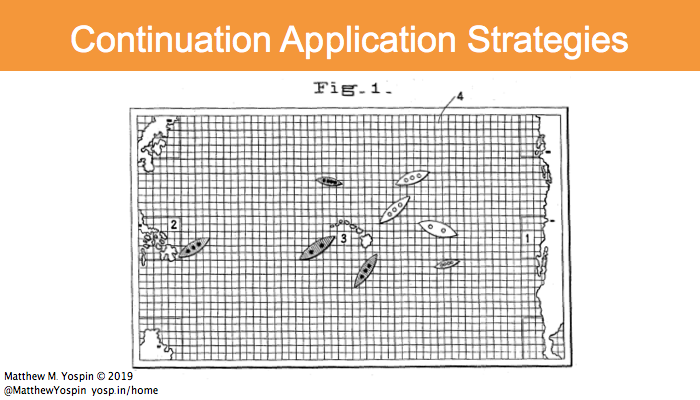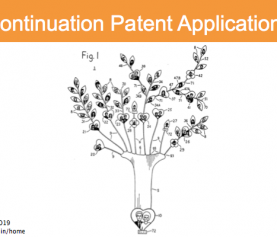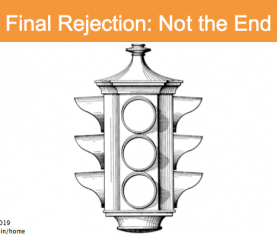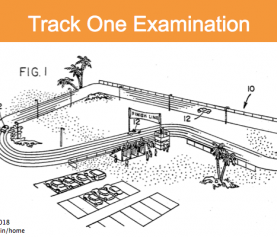Continuation application strategies for your patent family
When you are protecting your inventions – devices, software, methods, materials – with patent applications, you should consider ways to expand the scope of protection. You can use continuation application strategies to work towards increasing your market advantage, keeping your competitors guessing, and maintaining flexibility for your business as market conditions and patent law change. Continuation patent applications, divisional patent applications, and continuation-in-part patent applications should be used for any of these strategic reasons.
Claim additional aspects of your invention
First, you might want to expand your patent family, with claims to different aspects of your invention that were deemed to be separate inventions, or claims to broader subject matter related to your invention (broader than the prior claims). If you’ve received an Election/Restriction Requirement (see my blog post on that topic), a continuation patent application or divisional patent application can be used to begin examination of claims you didn’t choose (“elect”) earlier.
Expand your patent family
Second, continuation patent applications provide applicants with a relatively low-cost, and flexible, way to enlarge a patent portfolio. A larger patent portfolio is better for defense of your valuable inventions, and – if you’re ever looking for investors or seeking an exit with a sale of your company – they help to increase the value of your business. Continuation patent applications and divisional patent applications generally cost less than a first patent application in a patent family, because most of the application has already been written, leaving only the strategy and planning, writing of the claims, and preparation and filing of the application. Take a look at my blog posts on continuation patent applications and on patent application costs for more info.
Continuation application strategies to keep an edge over competitors
Third, having a patent application pending increases your options with regard to your competitors. By having an application pending, you could write additional claims in the future, and your competitors won’t know what you might do – which makes it hard for competitors to confidently design around your product or service (meaning, shape theirs so it doesn’t infringe your claims). In contrast, if patent prosecution is closed for a patent family, competitors can try to design around your issued patents with more certainty. Additionally, having at least one patent application pending makes it less likely that your patent family could be invalidated in future litigation, because you could get more claims issued, with your original priority date.
Keep your options open as the law changes
Fourth, having a patent application pending increases your options with regard to possible future changes in the standards for what is patentable subject matter. These can change with laws and court decisions, and having a pending patent application gives you the flexibility to write new claims that work around or make use of changes in the law. And, with a continuation patent application pending, you can date your priority to your original filing date, where your claims only relate to material that was disclosed in that original parent patent application.
Maintain flexibility for future innovations
Fifth, having a continuation or divisional patent application pending will allow you to write additional claims to variants that become important to your business in the future. With a continuation-in-part, you can describe additional inventions and keep some priority with your original filing date. In your business, as you continue innovating and improving your inventions, the ability to tie some priority back to your original patent filing – as well as, most likely, filing new patent applications – can help you protect your valuable innovations.
Spread costs over years
Sixth, this strategy allows you to spread the costs of provisional patent application out over more time, by filing one application, and filing child applications later, as you discover the value of the variants (or add to the invention, which would be a continuation-in-part patent application), as the market changes, or as your budget for the patent prosecution allows. By writing only a short set of claims to start, but with as detailed a specification and set of patent illustrations as possible, you can defer costs for claims that are directed to other variants of your invention.
Use the patent examination process to find related prior art
Seventh, you can use a parent application, with claims that are directed to an initial version of your product or service, to find out what the patent examiner finds that is related to your invention. Once the patent examiner has identified the prior art that is closest to your initial version of your product, you can write and file broader claims, or claims to a different version of your product or service, that potentially can be steered clear of the identified prior art.
Use a continuation patent application to accelerate patent examination
Eighth, if you’ve filed a patent application and decide you want faster patent prosecution, such as Track I examination or Accelerated examination, you can file a continuation patent application and file for Track I status for it. See my blog post on Track I examination for more detail on this topic. At present, you can’t speed up examination of a patent application after you’ve filed it (or after the day you filed it), so filing a continuation patent application can allow you to take advantage of Track I examination.
Questions on continuation application strategies?
Curious as to why I chose the image above for this blog post? It’s from US 972,382 for a Game Apparatus that looks similar to the familiar board game, Battleship, which I chose here for the multiple different strategies one can use in the game, of course! (Battleship is a trademark registered to Hasbro for a board game, and also is registered as other marks.) If you have questions on how or why to use a continuation patent application, call me at 617-340-9295 or email me at my Contact Me page. Or, find me on LinkedIn, YouTube, Facebook, Twitter, or Avvo.







[…] questions about your options for expanding your patent family? Take a look at my post discussing strategies for continuation patent applications. Call me at 617-340-9295 or email me at my Contact Me page. Or, find me on LinkedIn, YouTube, […]